Numerical Investigation of Arc-Pool-Metal Vapor Behavior in GTAW with an External Magnetic Field
Abstract
:1. Introduction
2. Numerical Model of a Composite Magnetic Generator
- The effect of inductance in the coil is ignored because the frequency is only 15 Hz in the experiments and simulation;
- the magnetic gap is ignored as the coils are twined tightly on the external magnetic field generator [15];
- the waveform of the excitation current is assumed to be the ideal waveform (square wave) produced by a precision-programmed power supply; and
- the alternating transient magnetic field, which changes periodically with time, can be equivalent to a direct-current stable magnetic field under the same excitation current.
3. Mathematical Model of GTAW with EMF
3.1. Basic Assumptions
- The fluids in the plasma arc and weld pool are incompressible and their flows are laminar [19].
- The Boussinesq approximation can be used to treat the buoyancy force in the weld pool.
- Metal vapor particles are treated as the same gas and electrically neutral.
- The influence of the metal vapor on the molten pool quality can be ignored.
3.2. Governing Equations
3.3. Computation Domain and Boundary Conditions
3.4. Energy Terms at the Interface
3.5. Welding Parameters and Material Properties
4. Results and Discussion
4.1. Magnetic Induction Intensity Distribution
4.2. Effect on Arc-Pool Behavior
4.3. Effect of the Metal Vapor on Arc and Molten Pool Behavior
4.4. Experimental Validation
5. Conclusions
- A three-dimensional numerical calculation model of an external compound magnetic field was established using a magnetic generator. The magnetic field distribution in the arc and workpiece was simulated using ANSYS software. The magnetic field intensity of the lower end of the magnetic pole was measured. A comparison shows that the results are in good agreement. This verifies the reliability of the numerical model.
- After the magnetic field is applied, the physical fields in the calculation domain are not symmetric along the tungsten electrode axis. The peak arc temperature is unchanged and the velocity decreases. Under the action of arc shear force and pressure, the metal on the weld pool surface flows to the front of the weld and then flows back to the center of the weld. The additional electromagnetic force is the main driving force for arc deflection, which has little effect on metal flow in the molten pool.
- A mathematical model of metal vapor was established. The deflection arc caused the high-temperature area of the workpiece to deviate from the tungsten electrode axis and the metal vapor exhibited an asymmetric distribution. The periodic swing of the arc reduced the welding heat input and the amount of metal vapor produced, as well as weakening its diffusion to the arc area. In the area where metal vapor was concentrated, the arc isotherms shrank and the temperature decreased by approximately 2500 K. In the area with less metal vapor, the arc temperature was basically unchanged. In the forward direction of welding (yoz plane), shrinkage of the welding arc led to a decrease in the workpiece heating area and a slight decrease in the melting depth. The melting width and the melting depth were increased in the vertical welding direction (xoz plane).
Author Contributions
Funding
Conflicts of Interest
References
- Yang, Z.; Cheng, Z. Development and application of new varieties of ultrapure ferrite stainless steel. China Metall. 2013, 23, 17–21. [Google Scholar]
- Chang, Y.; Gao, F.; Lu, L.; Gao, Y.; Liu, X. Research status and development trend of TIG welding technology. In Proceedings of the Forum on Development of Welding and Coating Technology in China Shipping and Marine Engineering, Guangzhou, China, 22 November 2012; pp. 33–38. [Google Scholar]
- Wu, H.; Chang, Y.; Lu, L.; Bai, J. Review on magnetically controlled arc welding process. Int. J. Adv. Manuf. Technol. 2017, 91, 4263–4273. [Google Scholar] [CrossRef]
- Li, T. Research status of electromagnetic field assisted welding technology. Welding 2017, 10, 18–24. [Google Scholar]
- Hicken, G.K.J.C.E. Effects of applied magnetic fields on welding arcs. Weld. J. 1966, 45, 515–525. [Google Scholar]
- Ando, K.; Nishikawa, J.; Yamanouchi, N. Effects of the magnetic field on bead formation in TIG arc welding. J. Jpn. Weld. Soc. 1968, 37, 41–50. [Google Scholar] [CrossRef] [Green Version]
- Ukita, S.; Kokubo, K.; Masuko, T.; Irie, T. High-speed DCEN TIG welding of very thin aluminium sheets with magnetic arc control. Weld. Int. 2003, 17, 541–549. [Google Scholar] [CrossRef]
- Pearce, B.P.; Kerr, H.W. Grain refinement in magnetically stirred GTA welds of aluminum alloys. Met. Mater. Trans. A 1981, 12, 479–486. [Google Scholar] [CrossRef]
- Jiang, C. Numerical Analysis of Thermal and Force Characteristics of MIG Arc under externally Applied Magnetic Field. Master’s Thesis, Shandong University, Jinan, China, 1 May 2019. [Google Scholar]
- Xiao, L.; Fan, D.; Huang, J. Three-dimensional numerical analysis of the interaction between a fixed point active tungsten inert gas arc welding and a molten pool. Chin. J. Mech. Eng. 2016, 52, 93–99. [Google Scholar] [CrossRef]
- Wang, C. Numerical Simulation of Temperature Field and Flow in TIG Welding Pool under Longitudinal Magnetic Field. Master’s Thesis, Chongqing University, Chongqing, China, 1 May 2014. [Google Scholar]
- Bachmann, M.; Avilov, V.; Gumenyuk, A.; Rethmeier, M. About the influence of a steady magnetic field on weld pool dynamics in partial penetration high power laser beam welding of thick aluminium parts. Int. J. Heat Mass Transf. 2013, 60, 309–321. [Google Scholar] [CrossRef]
- Tanaka, M.; Yamamoto, K.; Tashiro, S.; Nakata, K.; Yamamoto, E.; Yamazaki, K.; Suzuki, K.; Murphy, A.B.; Lowke, J. Time-dependent calculations of molten pool formation and thermal plasma with metal vapor in gas tungsten arc welding. J. Phys. D Appl. Phys. 2010, 43, 434009. [Google Scholar] [CrossRef] [Green Version]
- Jian, X.X.; Wu, C.S. Influence of Fe vapor on plasma arc welding molten pool behavior. Acta Metall. 2016, 52, 1467–1476. [Google Scholar]
- Kim, W.-H.; Fan, H.G.; Na, S.-J. Effect of various driving forces on heat and mass transfer in arc welding. Numer. Heat Transf. Part A Appl. 1997, 32, 633–652. [Google Scholar] [CrossRef]
- Li, Y. Numerical Analysis of Applied Electromagnetic Field Used to Regulate the Liquid Flow toward the Rear of High-Speed GMAW Molten Pool. Master’s Thesis, Shandong University, Jinan, China, 1 May 2015. [Google Scholar]
- Tanaka, M.; Lowke, J.J. Predictions of weld pool profiles using plasma physics. J. Phys. D Appl. Phys. 2006, 40, R1–R23. [Google Scholar] [CrossRef]
- Guo, Z.; Zhao, W. Arc and Thermal Plasma; Science Press: Beijing, China, 1986. [Google Scholar]
- Kim, W.-H.; Na, S.-J. Heat and fluid flow in pulsed current GTA weld pool. Int. J. Heat Mass Transf. 1998, 41, 3213–3227. [Google Scholar] [CrossRef]
- Pan, J. Numerical Analysis of Arc and Pool Characteristics of Nonmelting Polar Variable Polarity Welding of Aluminum Alloy. Ph.D. Thesis, Tianjin University, Tianjin, China, 1 December 2016. [Google Scholar]
- Voller, V.; Prakash, C. A fixed grid numerical modelling methodology for convection-diffusion mushy region phase-change problems. Int. J. Heat Mass Transf. 1987, 30, 1709–1719. [Google Scholar] [CrossRef]
- Prakash, C.; Voller, V. On the numerical solution of continuum mixture model equations describing binary solid-liquid phase change. Numer. Heat Transfer Part B Fundam. 1989, 15, 171–189. [Google Scholar] [CrossRef]
- Lu, F.; Wang, H.-P.; Murphy, A.B.; Carlson, B.E. Analysis of energy flow in gas metal arc welding processes through self-consistent three-dimensional process simulation. Int. J. Heat Mass Transf. 2014, 68, 215–223. [Google Scholar] [CrossRef]
- Tashiro, S.; Miyata, M.; Tanaka, M. Numerical analysis of AC tungsten inert gas welding of aluminum plate in consideration of oxide layer cleaning. Thin Solid Films 2011, 519, 7025–7029. [Google Scholar] [CrossRef]
- Jian, X.X.; Wu, C.S. Determination of arc pressure and current density on the molten pool surface in plasma arc welding. China Weld. (Eng. Ed.) 2014, 23, 78–82. [Google Scholar]
- Heberlein, J.; Murphy, A.B. Thermal plasma waste treatment. J. Phys. D Appl. Phys. 2008, 41, 053001. [Google Scholar] [CrossRef]
- Lowke, J.J.; Tanaka, M. ‘LTE-diffusion approximation’ for arc calculations. J. Phys. D Appl. Phys. 2006, 39, 3634. [Google Scholar] [CrossRef]
- Murphy, A.B. The effects of metal vapour in arc welding. J. Phys. D Appl. Phys. 2010, 43, 434001. [Google Scholar] [CrossRef]
- NIST Atomic Spectra Database Lines Form. Available online: https://physics.nist.gov/PhysRefData/ASD/lines_form.html (accessed on 30 June 2020).


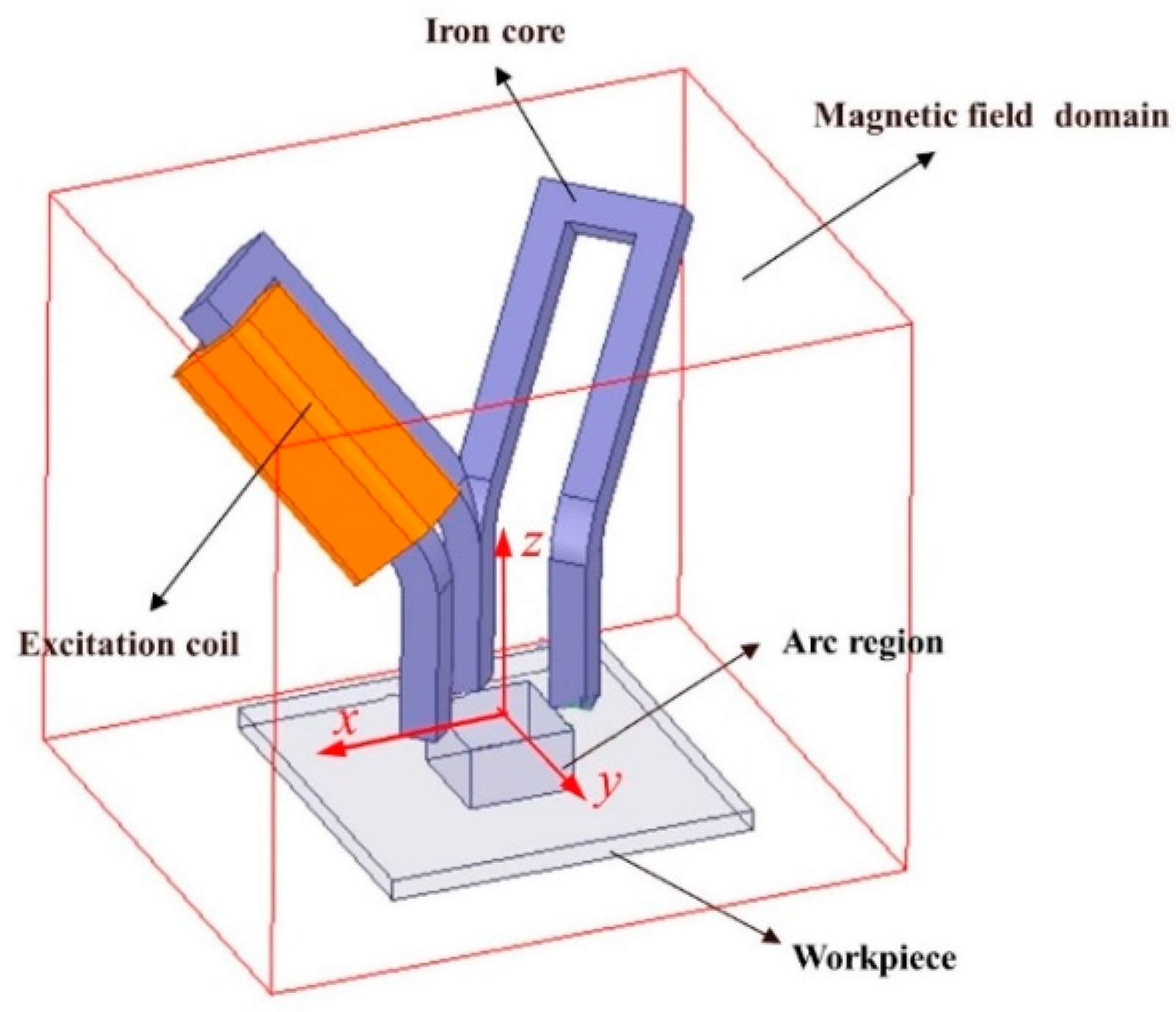


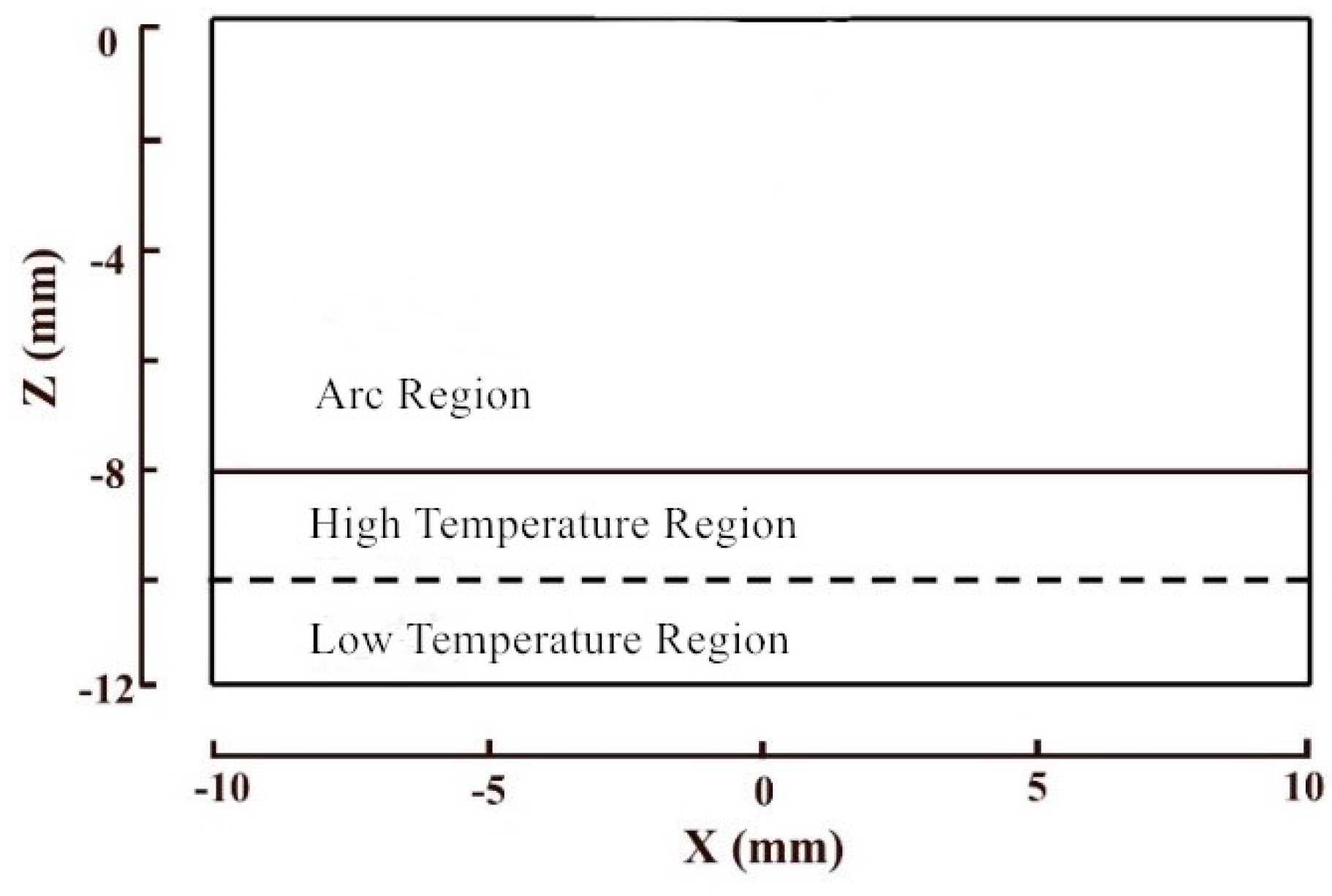
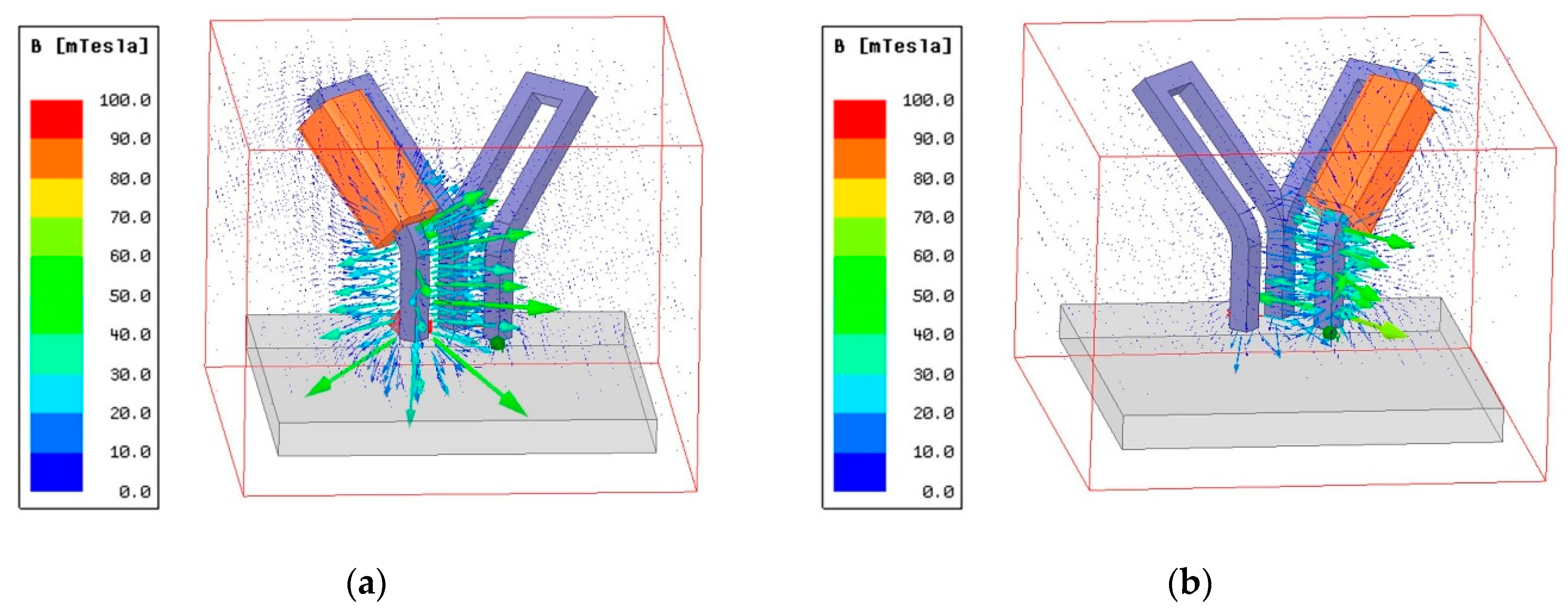
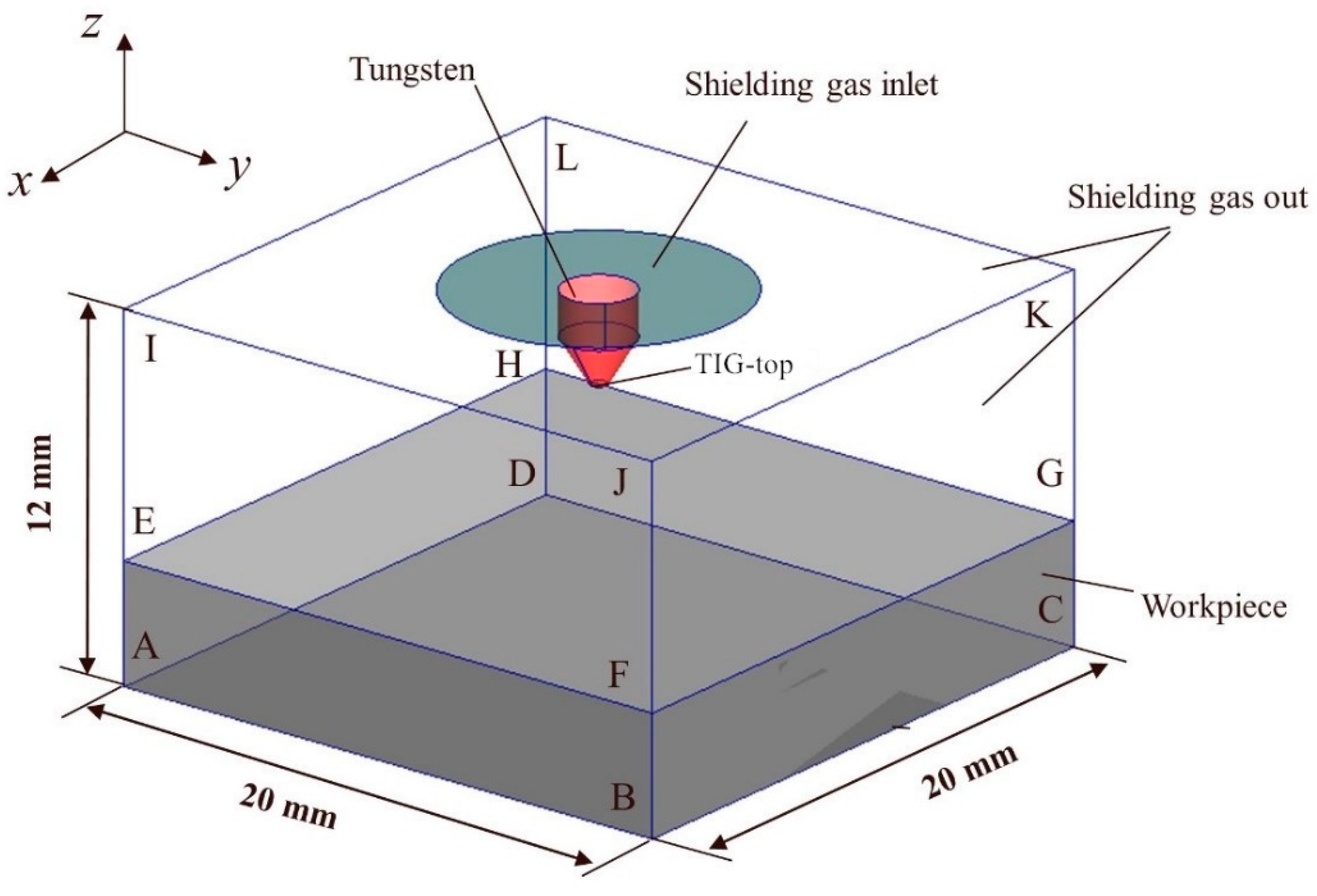
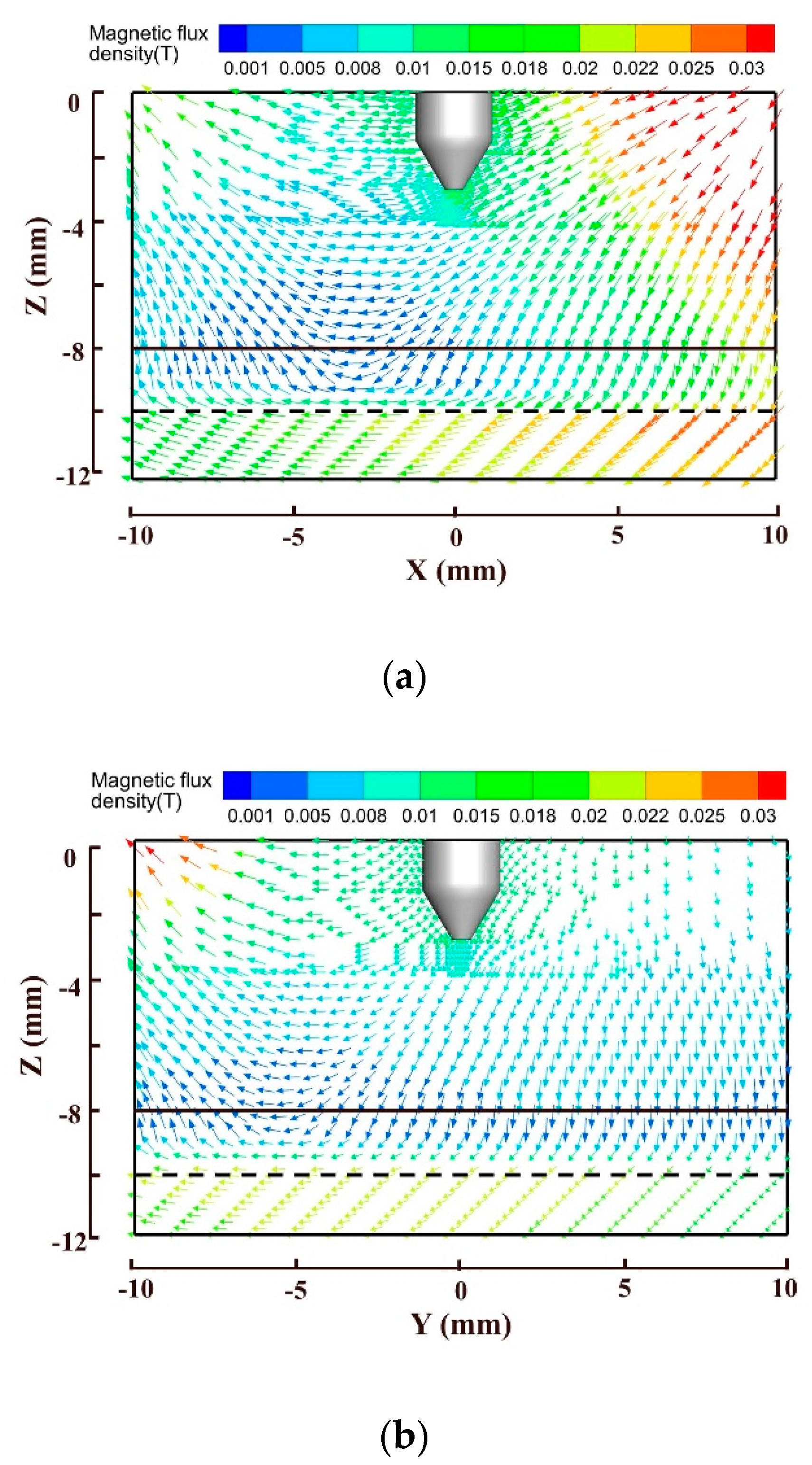
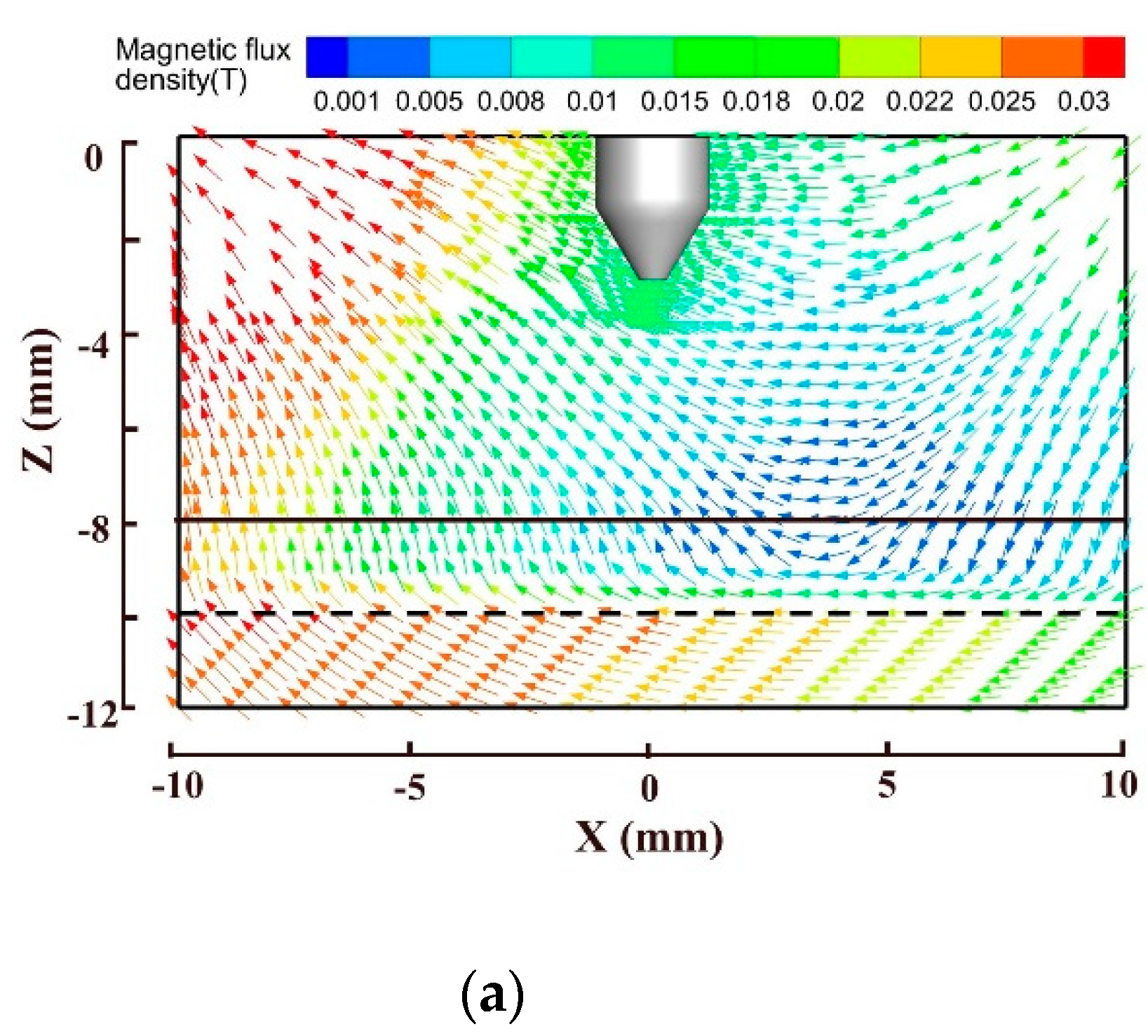


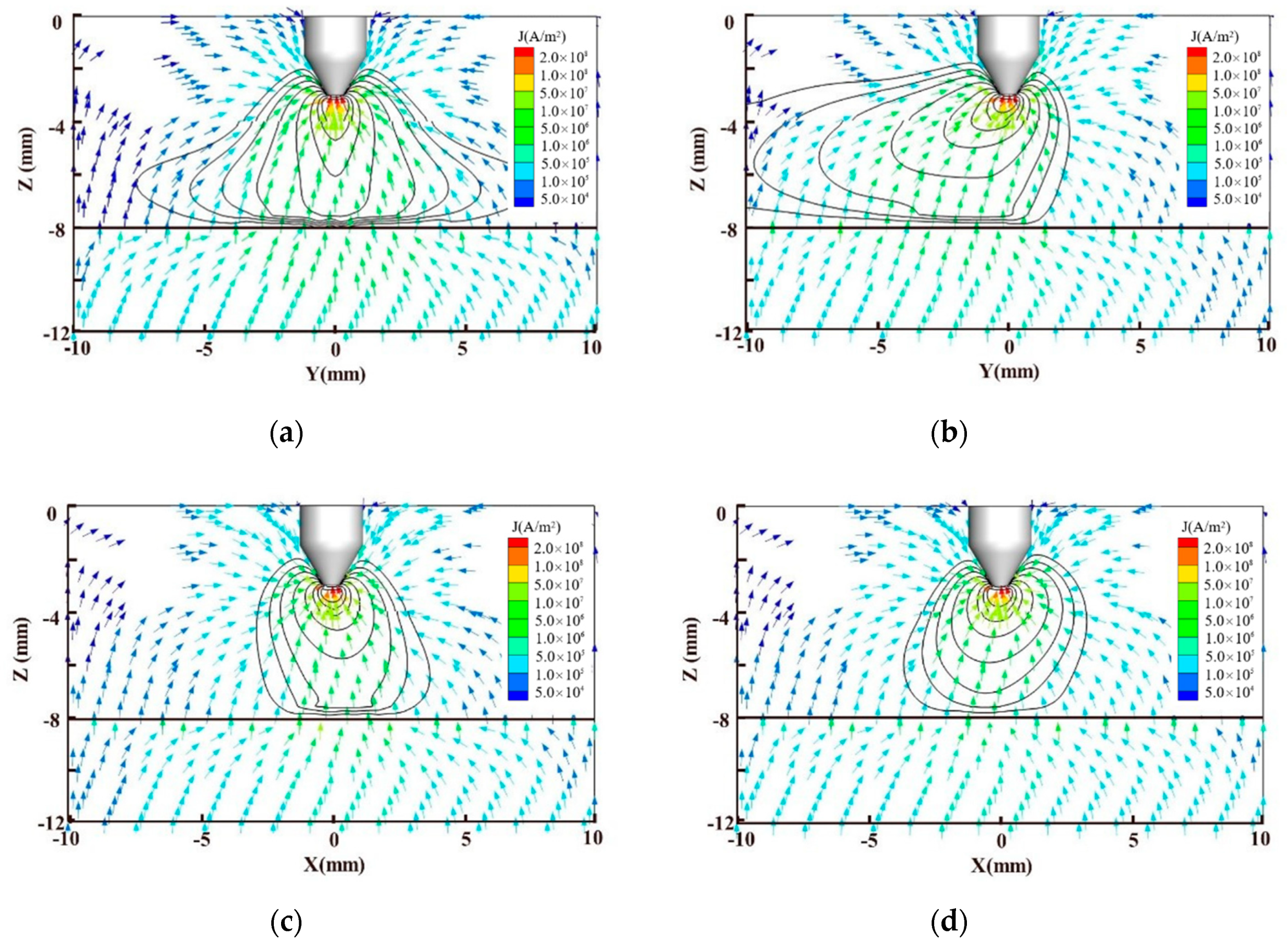
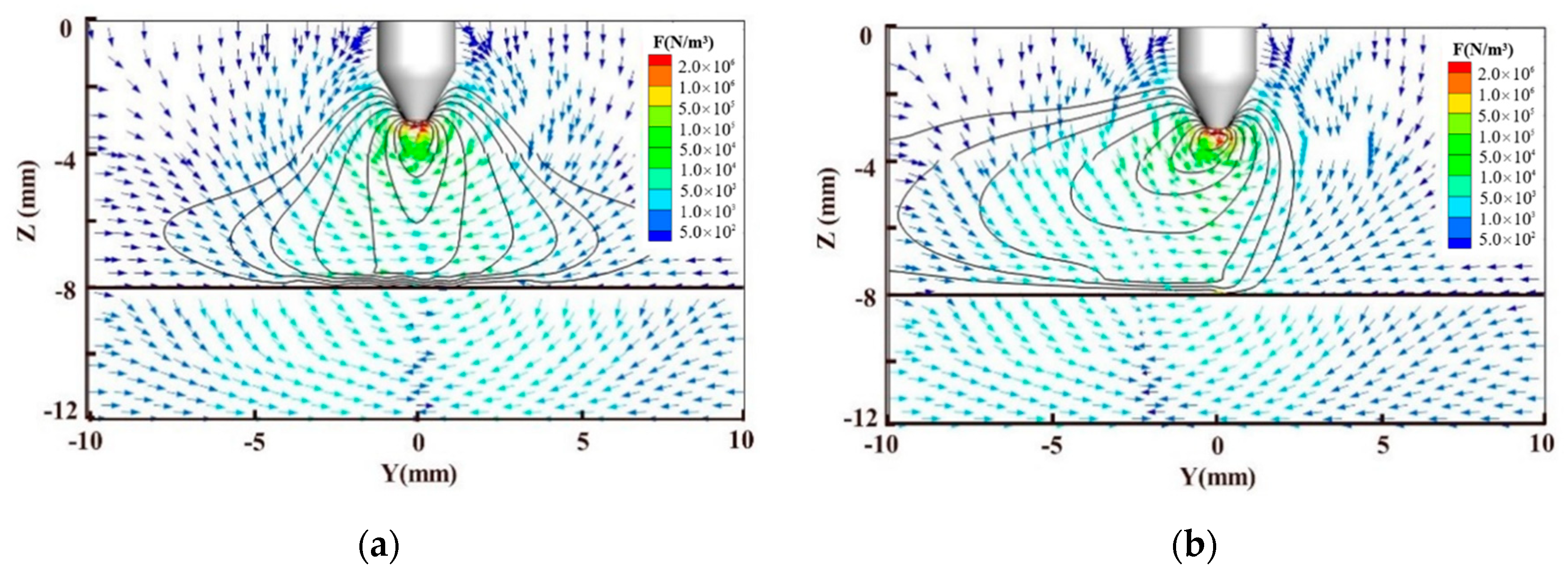
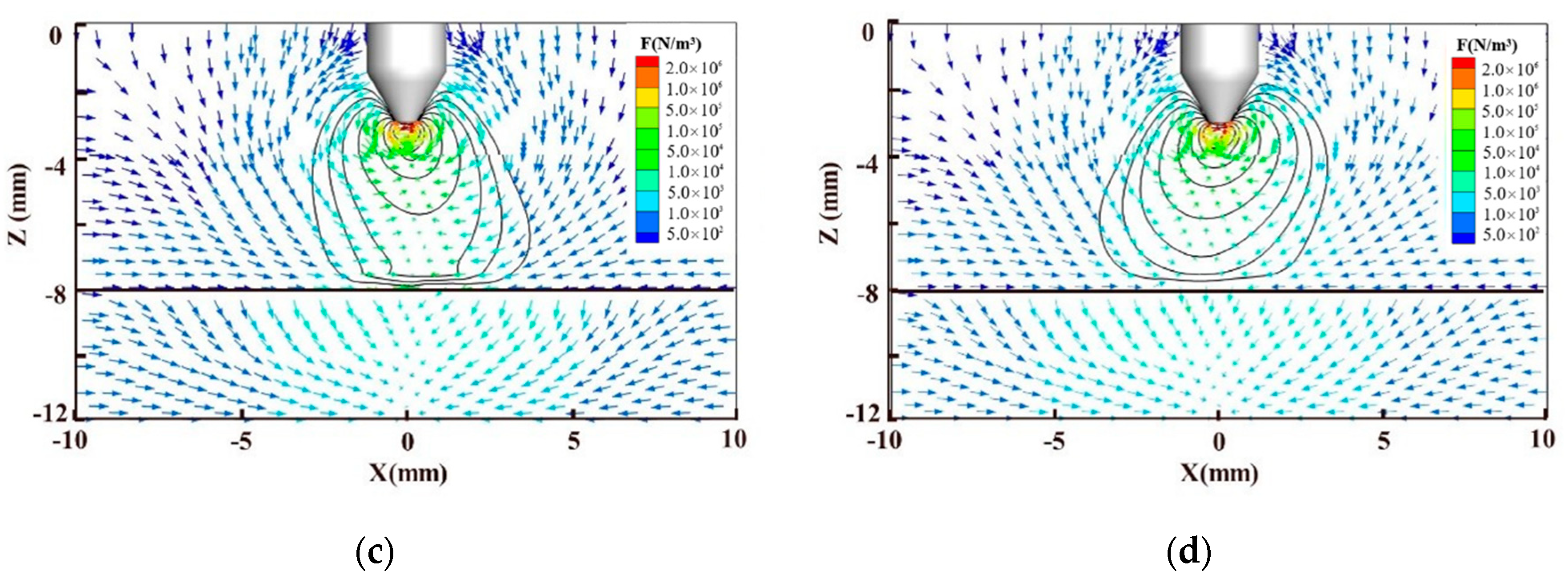


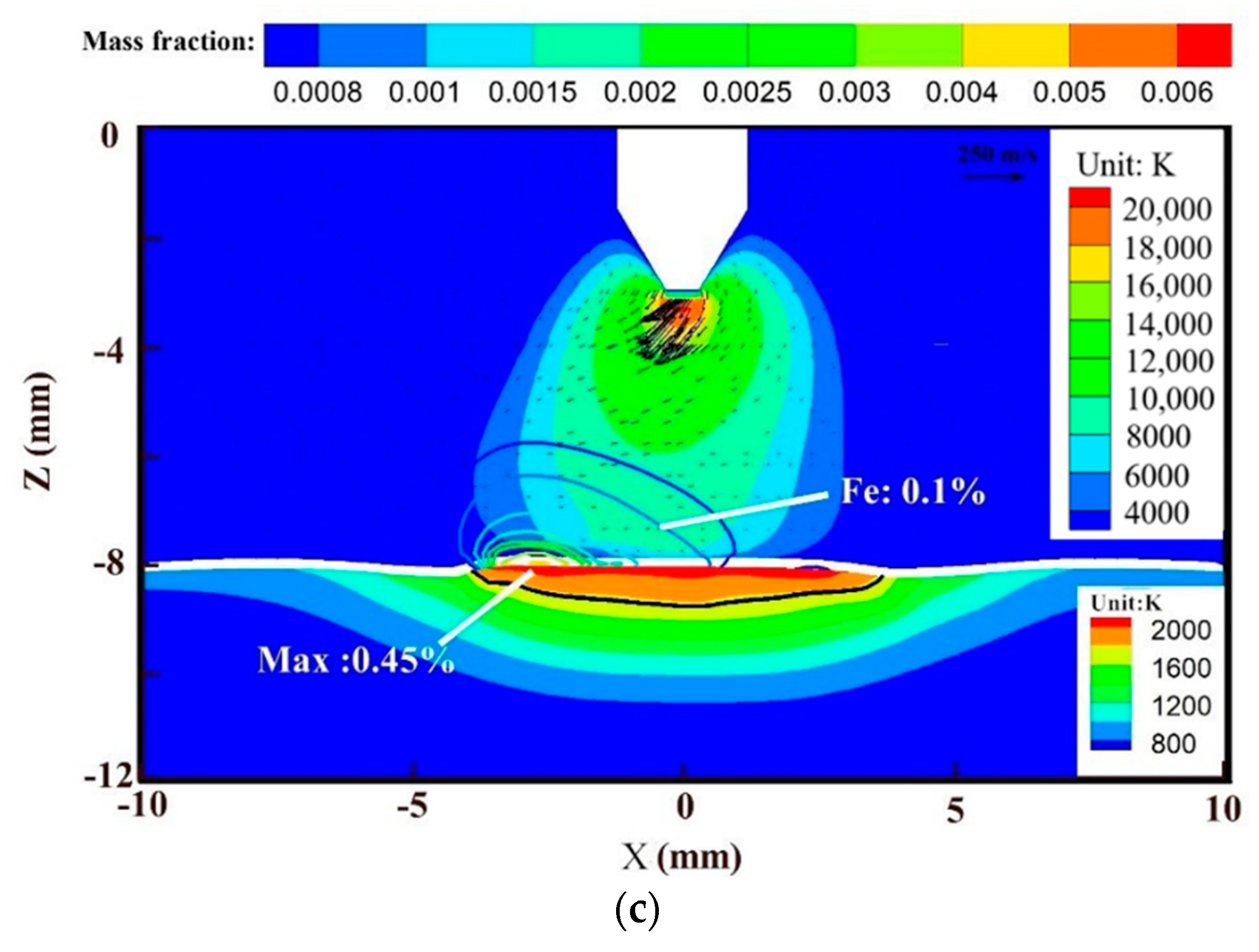

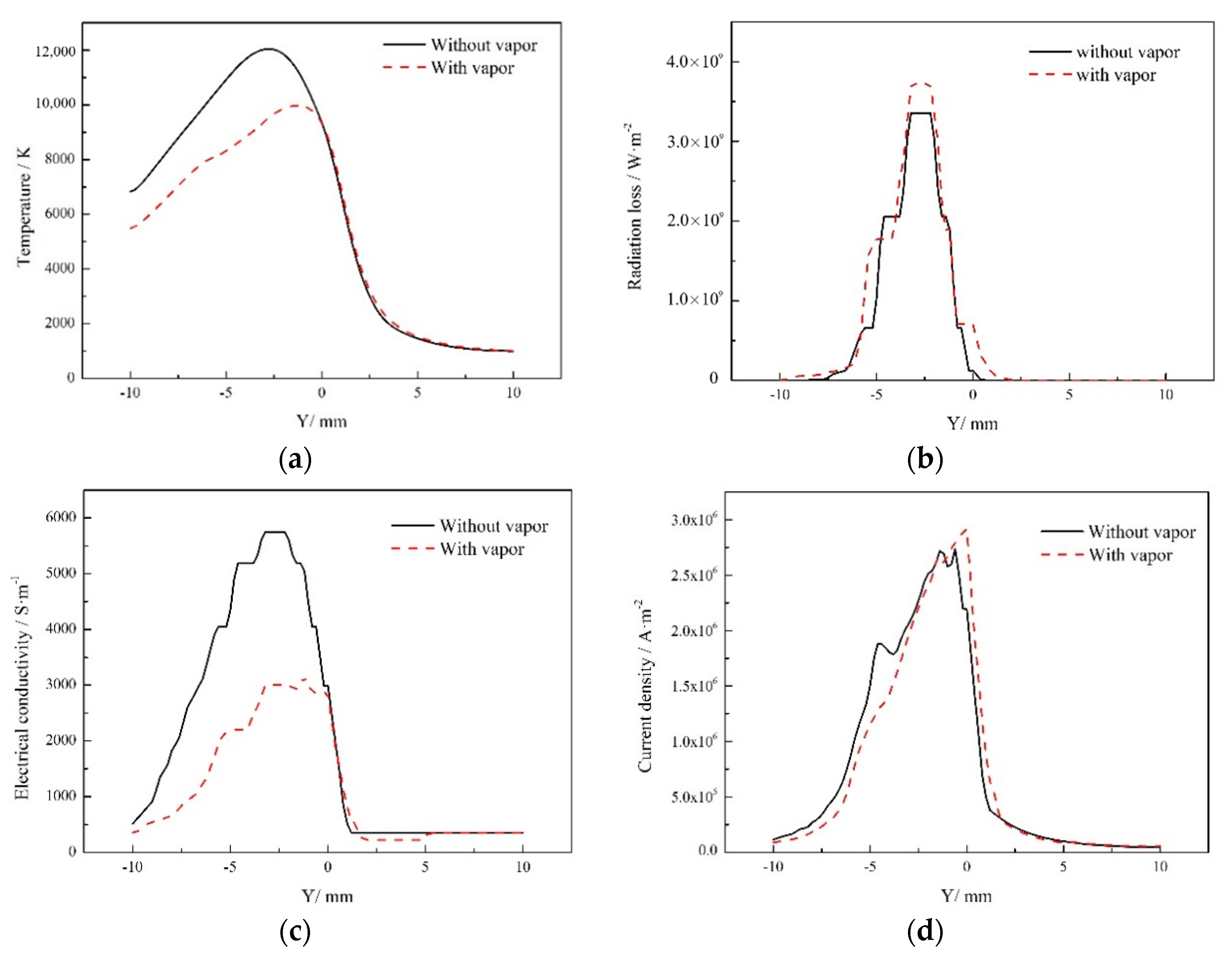






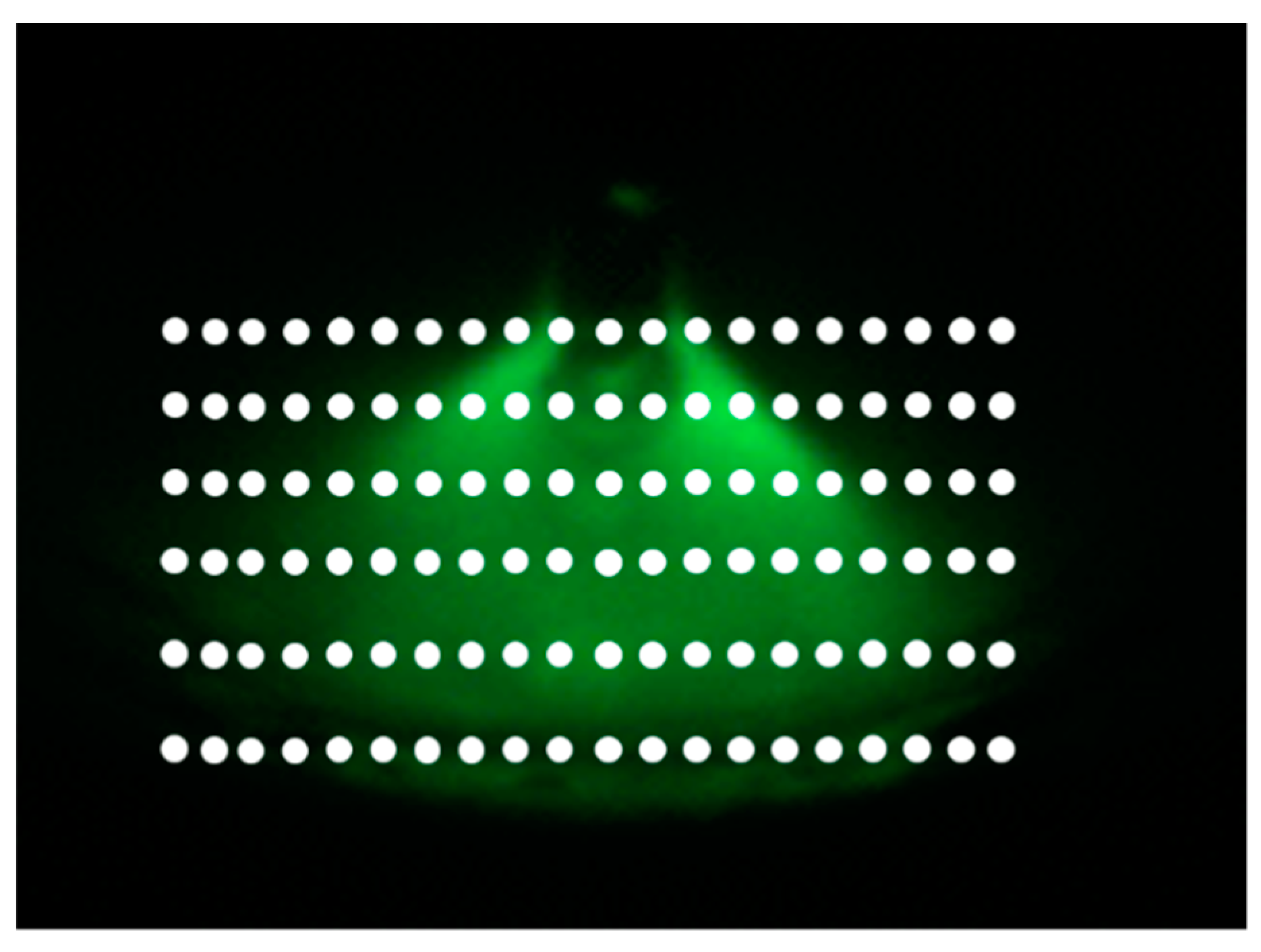
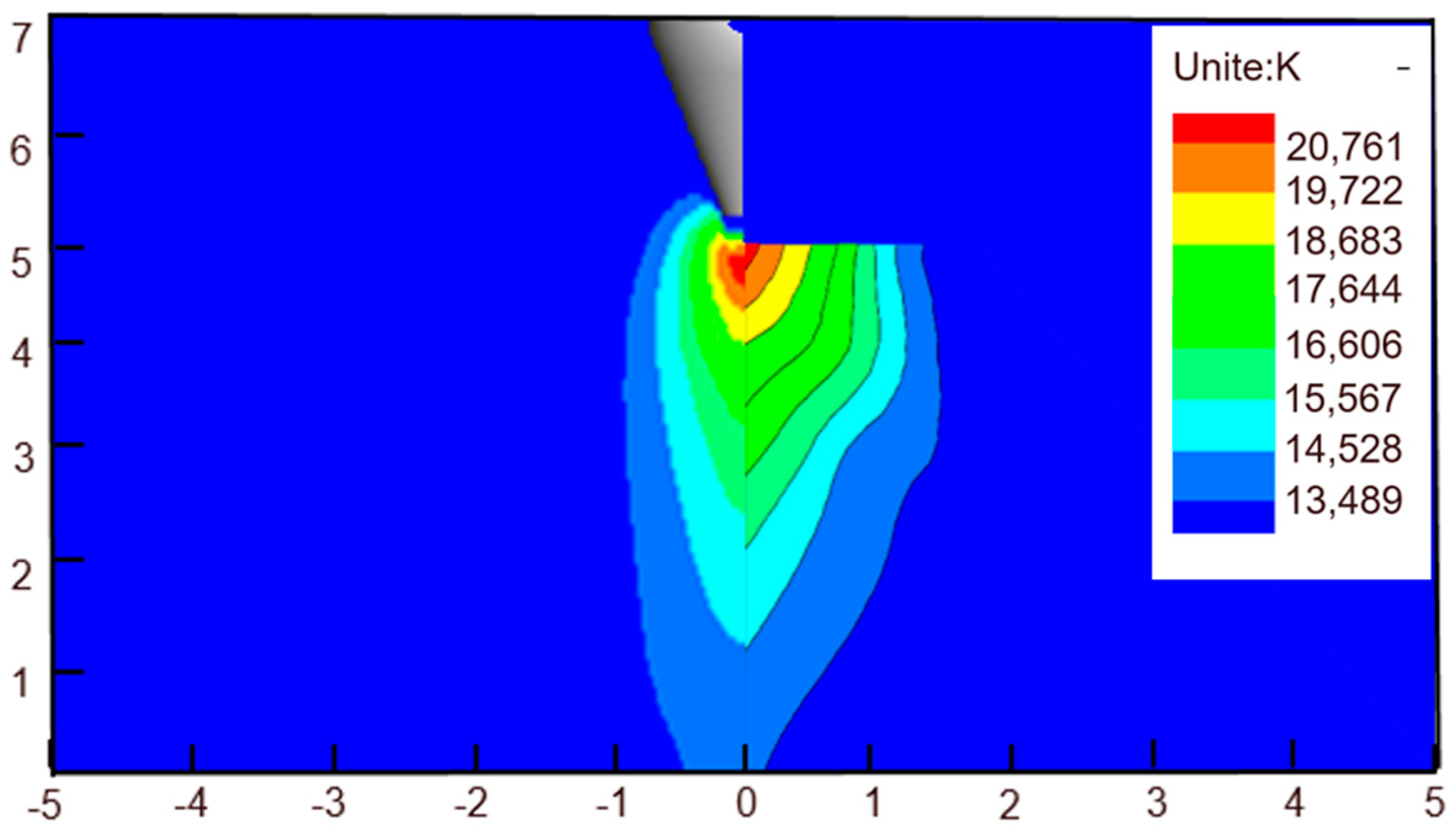
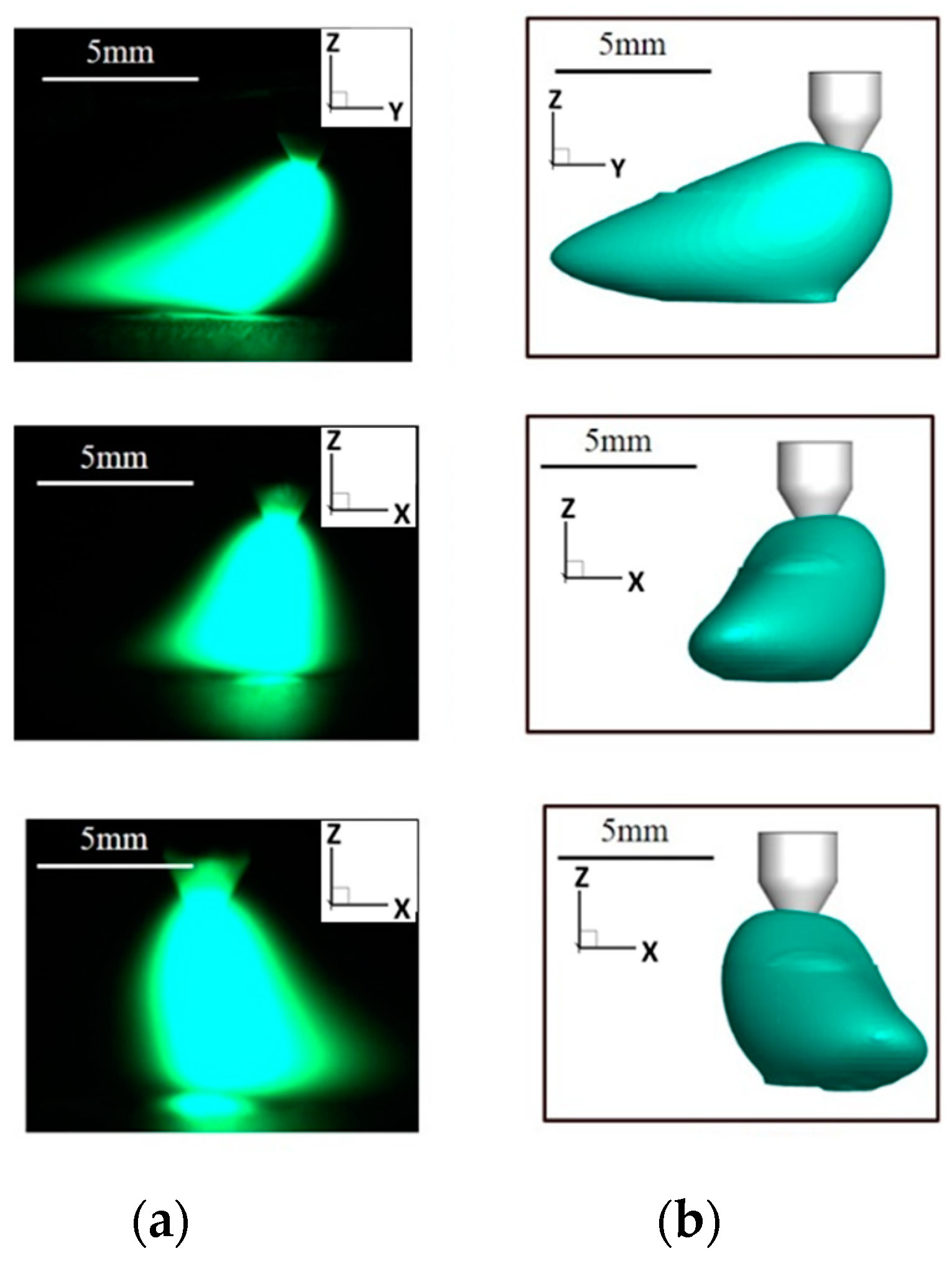
| Boundaries | V (m s−1) | T (K) | φ (V) | (T m) | Ym |
|---|---|---|---|---|---|
| Workpiece | — | ||||
| Shielding gas out | — | 1000 | 0 | ||
| Shielding gas inlet | 400 | ||||
| TIG-top | — | 2600 | j | ||
| Tungsten | — | 2000 |
| Parameter | Value |
|---|---|
| Distance from electrode to work piece (mm) | 5 |
| Workpiece thickness (mm) | 4 |
| Nozzle diameter (mm) | 9.6 |
| Shielding gas flow rate (L/min) | 20 |
| Welding current (A) | 200 |
| Nomenclature | Value |
|---|---|
| Density (kg m−3) | 7700 |
| Melting point (K) | 1741 |
| Freezing point (K) | 1781 |
| Electric conductivity (S m−1) | 7.0 × 105 |
| Surface tension coefficient (N m−1) | 1.64 |
| Surface tension temperature gradient (N m−1 K−1) | −4 × 10−4 |
| Work function (V) | 4.65 |
| Methods | Leaning | Right | Left |
|---|---|---|---|
| Experiment | 33.81° | 11.18° | 11.38° |
| Simulation | 34.22° | 10.94° | 10.86° |
© 2020 by the authors. Licensee MDPI, Basel, Switzerland. This article is an open access article distributed under the terms and conditions of the Creative Commons Attribution (CC BY) license (http://creativecommons.org/licenses/by/4.0/).
Share and Cite
Han, Y.; Chen, J.; Li, L.; Wang, L.; Wu, C. Numerical Investigation of Arc-Pool-Metal Vapor Behavior in GTAW with an External Magnetic Field. Metals 2020, 10, 1199. https://doi.org/10.3390/met10091199
Han Y, Chen J, Li L, Wang L, Wu C. Numerical Investigation of Arc-Pool-Metal Vapor Behavior in GTAW with an External Magnetic Field. Metals. 2020; 10(9):1199. https://doi.org/10.3390/met10091199
Chicago/Turabian StyleHan, Yu, Ji Chen, Linqi Li, Lin Wang, and Chuansong Wu. 2020. "Numerical Investigation of Arc-Pool-Metal Vapor Behavior in GTAW with an External Magnetic Field" Metals 10, no. 9: 1199. https://doi.org/10.3390/met10091199





